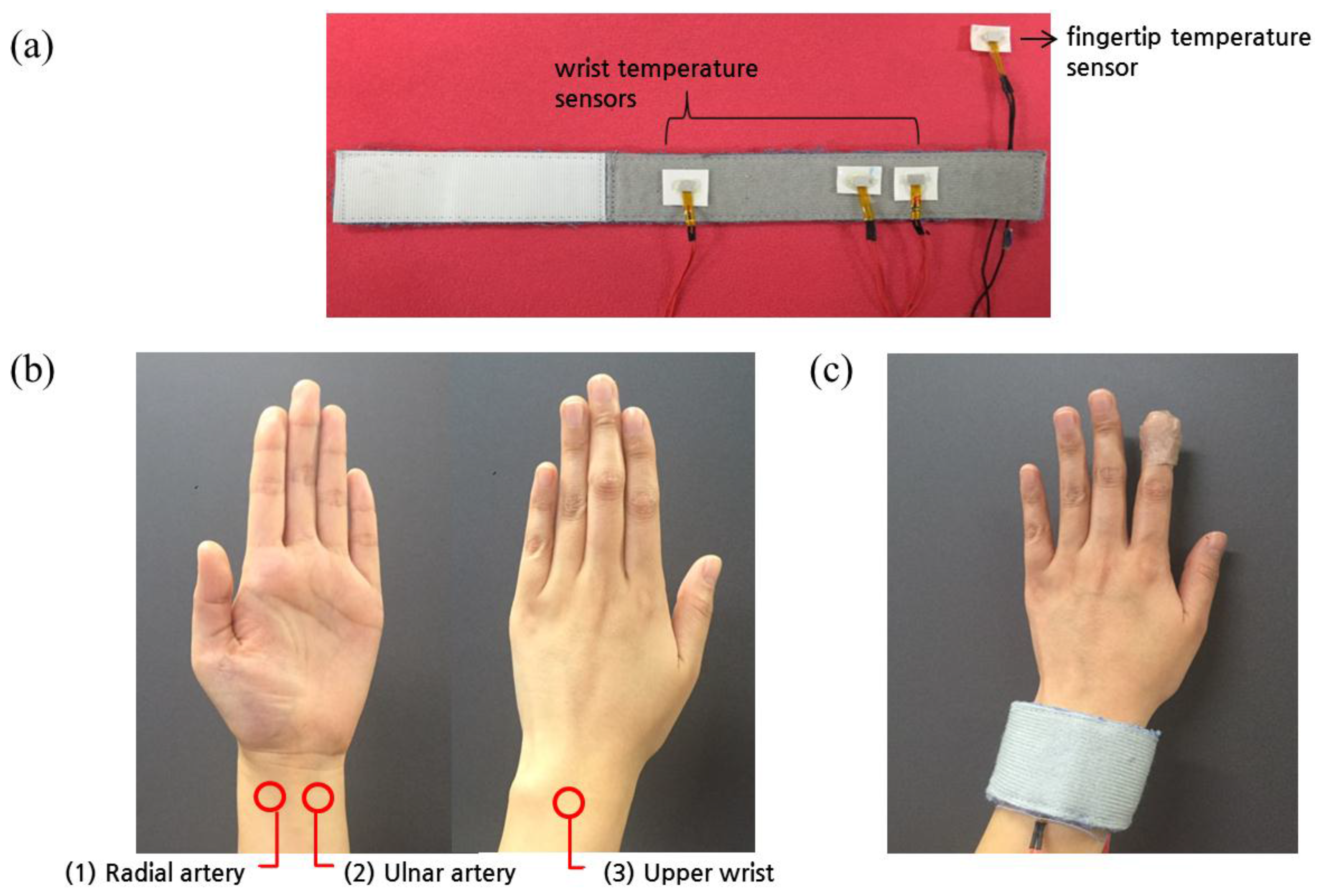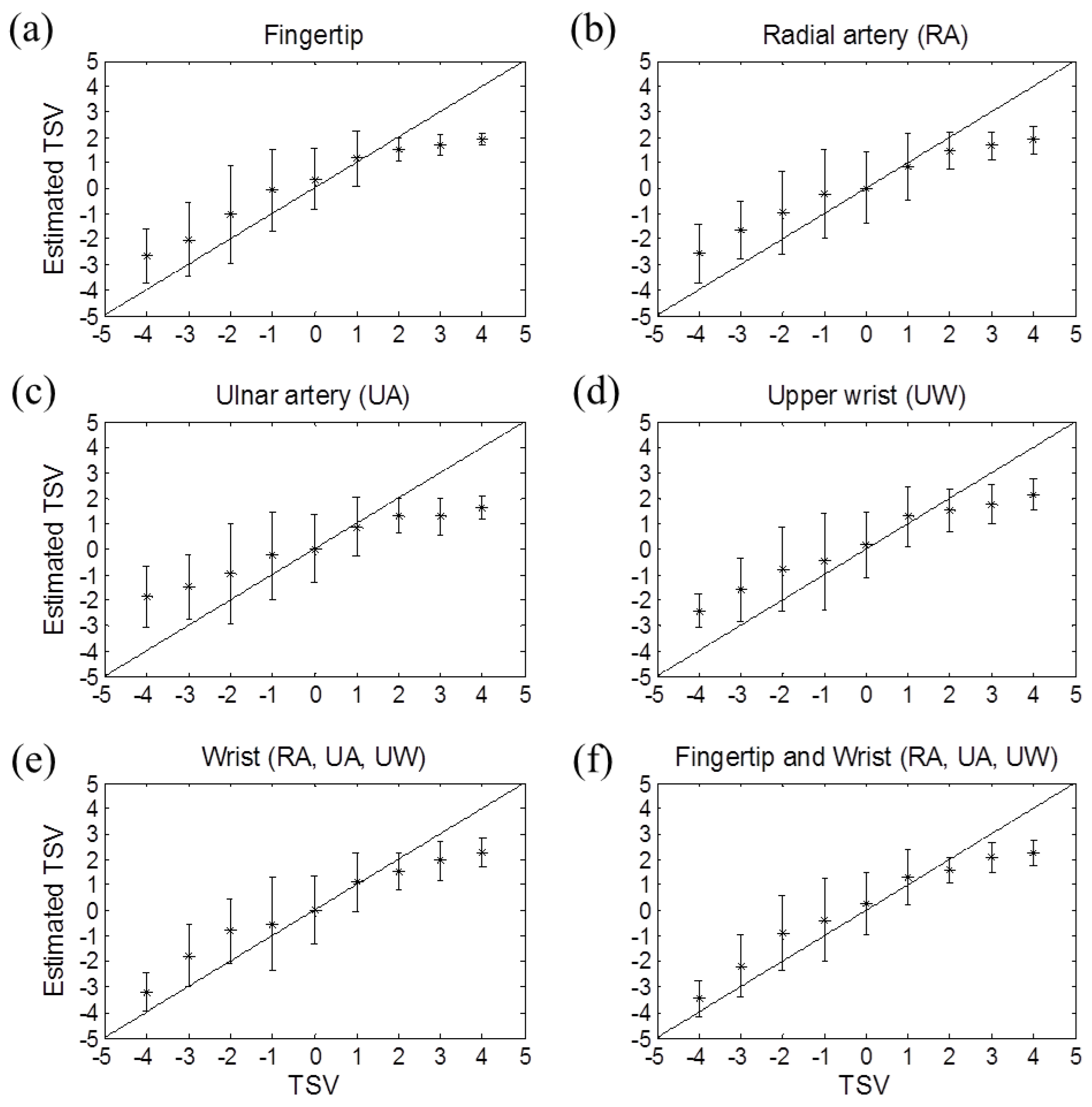Estimation of Thermal Sensation Based on Wrist Skin Temperatures
Abstract
:1. Introduction
2. Experimental Methods
2.1. Wrist Skin Temperature Monitoring Device
2.2. Experimental Protocol
2.3. Development of the Thermal Sensation Estimation Model
3. Results and Discussion
3.1. Relationship between the Skin Temperatures and Thermal Sensation
3.2. Development of the Thermal Sensation Estimation Model
4. Conclusions
Acknowledgments
Author Contributions
Conflicts of Interest
References
- ASHRAE. ANSI/ASHRAE Standard 55–2004: Thermal Environmental Conditions for Human Occupancy; American Society of Heating, Refrigerating and Air-Conditioning Engineers (ASHRAE): Atlanta, GA, USA, 2004. [Google Scholar]
- Venneti, K.; Lenin, M.; Thilagavathy, D.A. Ban technology based wearable wireless sensors for real-time environments. Appl. Mech. Mater. 2014, 573, 381–387. [Google Scholar] [CrossRef]
- Nakayama, K.; Suzuki, T.; Kameyama, K. Estimation of thermal sensation using human peripheral skin temperature. In Proceedings of the 2009 IEEE International Conference on Systems, Man, and Cybernetics, San Antonio, TX, USA, 11–14 October 2009; pp. 2872–2877.
- Rawi, M.I.M.; Al-Anbuky, A. Wireless sensor networks and human comfort index. Pers. Ubiquit Comput 2013, 17, 999–1011. [Google Scholar] [CrossRef]
- Garcia-Souto, M. Temperature and Comfort Monitoring Systems for Humans. Ph.D. Thesis, Queen Mary University of London, London, UK, 2012. [Google Scholar]
- Wang, D.; Zhang, H.; Arens, E.; Huizenga, C. Observations of upper-extremity skin temperature and corresponding overall-body thermal sensations and comfort. Build Environ. 2007, 42, 3933–3943. [Google Scholar] [CrossRef]
- Fanger, P.O. Thermal Comfort: Analysis and Applications in Environmental Engineering; Danish Technical Press: Copenhagen, Denmark, 1970. [Google Scholar]
- Gagge, A.P.; Fobelets, A.P.; Berglund, L.G. A standard predictive index of human response to the thermal environment. In Proceedings of ASHRAE Transactions, Portland, OR, USA, 22–25 June 1986; pp. 709–731.
- Ye, G.; Yang, C.; Chen, Y.; Li, Y. A new approach for measuring predicted mean vote (PMV) and standard effective temperature (SET∗). Build Environ. 2003, 38, 33–44. [Google Scholar] [CrossRef]
- Sugimoto, C. Human sensing using wearable wireless sensors for smart environments. In Proceedings of 2013 Seventh International Conference on Sensing Technology (ICST), Wellington, New Zealand, 3–5 December 2013; pp. 188–192.
- Takada, S.; Matsumoto, S.; Matsushita, T. Prediction of whole-body thermal sensation in the non-steady state based on skin temperature. Build Environ. 2013, 68, 123–133. [Google Scholar] [CrossRef]
- Yao, Y.; Lian, Z.; Liu, W.; Shen, Q. Experimental study on skin temperature and thermal comfort of the human body in a recumbent posture under uniform thermal environments. Indoor Built Environ. 2007, 16, 505–518. [Google Scholar] [CrossRef]
- Humphreys, M.A.; McCartney, K.J.; Nicol, J.; Raja, I.A. An analysis of some observations of the finger temperature and thermal comfort of office workers. In Proceedings of the 8th International Conference on Indoor Air Quality and Climate, Edinburgh, Scotland, 8–13 August 1999; pp. 602–607.
- Choi, J.H.; Loftness, V. Investigation of human body skin temperatures as a bio-signal to indicate overall thermal sensations. Build Environ. 2012, 58, 258–269. [Google Scholar] [CrossRef]
- Jacquot, C.M.; Schellen, L.; Kingma, B.R.; van Baak, M.A.; van Marken Lichtenbelt, W.D. Influence of thermophysiology on thermal behavior: The essentials of categorization. Physiol. Behav. 2014, 128, 180–187. [Google Scholar] [CrossRef] [PubMed]
- Zhang, H.; Arens, E.; Huizenga, C.; Han, T. Thermal sensation and comfort models for non-uniform and transient environments: Part I: Local sensation of individual body parts. Build Environ. 2010, 45, 380–388. [Google Scholar] [CrossRef]
- Hensel, H. Thermoreception and temperature regulation. Monogr. Physiol. Soc. 1981, 38, 33–35. [Google Scholar]
- Ring, J.W.; de Dear, R. Temperature transients: A model for heat diffusion through the skin, thermoreceptor response and thermal sensation. Indoor Air 1991, 4, 448–456. [Google Scholar] [CrossRef]
- House, J.R.; Tipton, M.J. Using skin temperature gradients or skin heat flux measurements to determine thresholds of vasoconstriction and vasodilatation. Eur. J. Appl. Physiol. 2002, 88, 141–145. [Google Scholar] [CrossRef] [PubMed]
- Schellen, L.; Loomans, M.G.; de Wit, M.H.; Olesen, B.W.; van Marken Lichtenbelt, W.D. The influence of local effects on thermal sensation under non-uniform environmental conditions—Gender differences in thermophysiology, thermal comfort and productivity during convective and radiant cooling. Physiol. Behav. 2012, 107, 252–261. [Google Scholar] [CrossRef] [PubMed]
- Karjalainen, S. Thermal comfort and gender: A literature review. Indoor Air 2012, 22, 96–109. [Google Scholar] [CrossRef] [PubMed]







| No. | Measurement Part | Estimation Model | Adjusted R2 |
|---|---|---|---|
| 1 | Fingertip | TSV = 0.404 × mSKT + 0.918 × dSKT − 94,517.830 × BP[0.05-0.1] − 387,622.240 × BP[0.1-0.2] − 12.573 | 0.62 |
| 2 | Radial artery | TSV = 0.670 × mSKT + 6.478 × dSKT − 4,009,175.078 × BP[0.2-0.3] − 22.127 | 0.58 |
| 3 | Ulnar artery | TSV = 0.644 × mSKT + 5.163 × dSKT − 4,051,375.063 × BP[0.2-0.3] − 21.515 | 0.50 |
| 4 | Upper wrist | TSV = 0.568 × mSKT + 6.414 × dSKT − 5,007,825.940 × BP[0.3-0.5] − 18.159 | 0.61 |
| 5 | Radial artery, ulnar artery, and upper wrist | TSV = 0.568 × mSKTUW +1.048 × gSKT(RA-UA)+ 7.917 × dSKTUW − 1.931 x dSKTg(RA-UA) + 5.035 × dSKTg(RA-UW) + 3,625,372.499 × BPUA[0.2-0.3] − 5,033,252.737 × BPUW[0.3-0.5] − 17.996 | 0.68 |
| 6 | Fingertip, radial artery, ulnar artery, and upper wrist | TSV = 0.322 × mSKTRA + 0.656 × gSKT(RA-UA) − 0.681 × gSKT(UA-UW) + 1.950 × dSKTRA + 2.351 × dSKTUA + 0.512 × dSKTg(FIN-UA) − 74,000.163 × BPFIN[0.05-0.1] − 238,485.732 × BPFIN[0.1-0.2] + 4,154,333.783 × BPUA[0.2-0.3] − 4,569,372.572 × BPUW[0.3-0.5] − 8.970 | 0.72 |
| No. | Measurement part | Mean RMSE | Mean Bias | r |
|---|---|---|---|---|
| 1 | Fingertip | 1.43 ± 0.46 | 0.00 ± 0.82 | 0.79 |
| 2 | Radial artery | 1.52 ± 0.33 | −0.08 ± 0.82 | 0.76 |
| 3 | Ulnar artery | 1.70 ± 0.41 | −0.12 ± 0.99 | 0.69 |
| 4 | Upper wrist | 1.53 ± 0.29 | 0.02 ± 0.83 | 0.76 |
| 5 | Radial artery, ulnar artery, and upper wrist | 1.39 ± 0.18 | −0.05 ± 0.73 | 0.81 |
| 6 | Fingertip, radial artery, ulnar artery, and upper wrist | 1.26 ± 0.31 | −0.01 ± 0.63 | 0.84 |
| No. | Measurement Part | Mean RMSE | Mean Bias | r |
|---|---|---|---|---|
| 1 | Fingertip | 1.18 ± 0.48 | 0.09 ± 0.21 | 0.85 |
| 2 | Radial artery | 1.19 ± 0.38 | 0.06 ± 0.31 | 0.86 |
| 3 | Ulnar artery | 1.24 ± 0.39 | 0.04 ± 0.25 | 0.84 |
| 4 | Upper wrist | 1.16 ± 0.39 | 0.04 ± 0.21 | 0.86 |
| 5 | Radial artery, ulnar artery, and upper wrist | 1.06 ± 0.29 | −0.01 ± 0.24 | 0.89 |
| 6 | Fingertip, radial artery, ulnar artery, and upper wrist | 0.95 ± 0.21 | −0.06 ± 0.18 | 0.92 |
© 2016 by the authors; licensee MDPI, Basel, Switzerland. This article is an open access article distributed under the terms and conditions of the Creative Commons by Attribution (CC-BY) license (http://creativecommons.org/licenses/by/4.0/).
Share and Cite
Sim, S.Y.; Koh, M.J.; Joo, K.M.; Noh, S.; Park, S.; Kim, Y.H.; Park, K.S. Estimation of Thermal Sensation Based on Wrist Skin Temperatures. Sensors 2016, 16, 420. https://doi.org/10.3390/s16040420
Sim SY, Koh MJ, Joo KM, Noh S, Park S, Kim YH, Park KS. Estimation of Thermal Sensation Based on Wrist Skin Temperatures. Sensors. 2016; 16(4):420. https://doi.org/10.3390/s16040420
Chicago/Turabian StyleSim, Soo Young, Myung Jun Koh, Kwang Min Joo, Seungwoo Noh, Sangyun Park, Youn Ho Kim, and Kwang Suk Park. 2016. "Estimation of Thermal Sensation Based on Wrist Skin Temperatures" Sensors 16, no. 4: 420. https://doi.org/10.3390/s16040420






